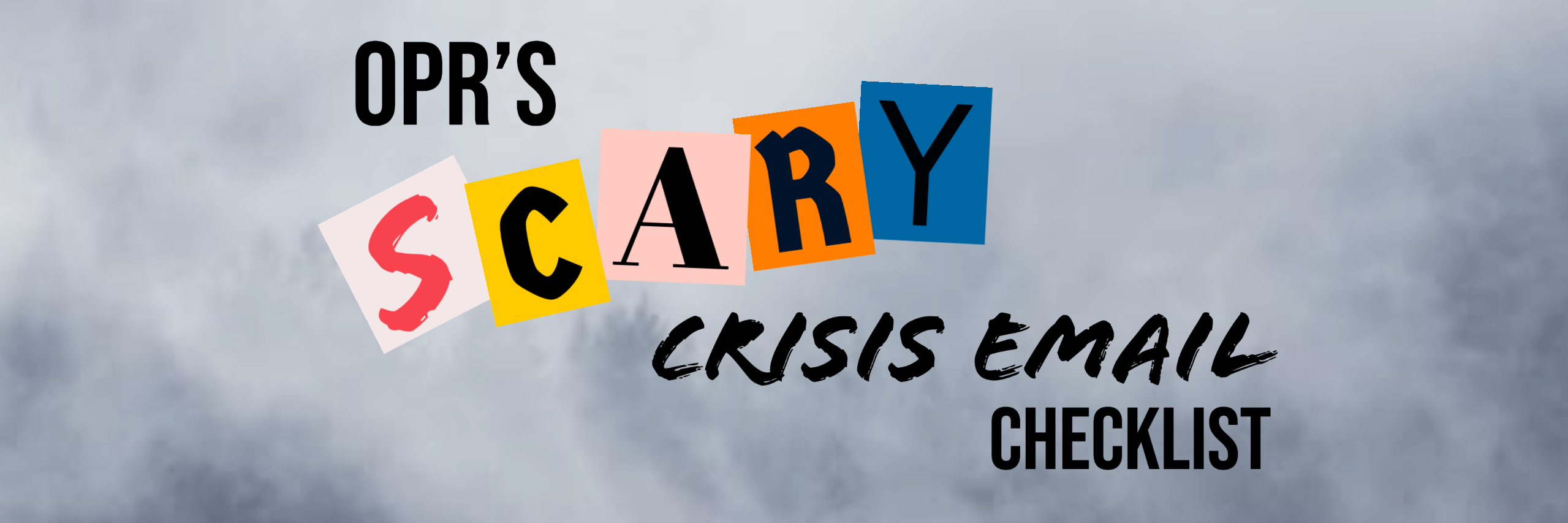What to do when a *scary* crisis email hits your inbox

For me, the best part of the haunted house is the unexpected scare. When you walk through the maze named “Dracula’s Den,” you’re anticipating the vampire hanging from the rafters. You might even expect the fanged creature that emerges from its coffin right as you walk by. What you’re not anticipating is one of the presumed victims of Transylvania to sit up from its slumber and scream to you for help.
Haunted house newcomers all react the same way to an unexpected scare. They freeze, scream and end up in the clutches of the scary entity for far longer than is necessary. The professionals, like me, shout from behind them, “KEEP MOVING!”
We’re three paragraphs in, and you’re probably saying to yourself, “This is supposed to be a blog post about crisis emails.” And here’s where I draw the connection. As a public relations practitioner, I do my best to plan out my client work for the week. I anticipate the client meetings on my calendar and even add some buffer time to answer real-time questions from my account partners. If life didn’t happen between Monday and Friday, I would execute tasks without a hitch. But life does happen, and I will likely receive a bone-chilling, truly horrifying email sometime throughout the month.
When a scary, day-changing crisis email hits my inbox, it takes everything in my power not to slam my palm on the panic button and freeze like the rookies navigating Dracula’s Den. It’s taken nearly four and a half years at the firm to find the resolve that keeps me moving forward in spite of a setback. The process of getting there was painful (it didn’t involve literal screaming, but some shouting might have been heard). That is why I’m uniquely qualified to guide you through the process of managing a scary email while still trying to knock out your pre-scheduled work.
Assess – What am I looking at, and is it truly scary?
Some emails require you to drop everything and completely adjust, and others can be carefully woven into your planned tasks. Not all crises are of equal severity, so placing the crisis within the grand scheme of your client’s work or industry can help you find perspective. Then, ask critical questions related to your work for that client and your relationship with their organization. For example, you might ask: “Does this problem, issue or crisis demand immediate action on my part, or do I need to be involved later in the process?” Then, consider whether the contents of the email are truly urgent. When I received an email that a patron had driven into the front window of my client’s business, that was an urgent and immediate crisis I needed to address. If a client sends you a heads-up that they might need your help spreading the word about a canceled event, you can wait until they give you the word to dive in head first.
Move – Even though I’m petrified, how can I keep moving forward?
As I mentioned above, not all scary emails mandate immediate action. In fact, oftentimes when a client gives you advance notice of a potential crisis or issue, starting on work immediately isn’t in your best interest. You might need more information or specific details before you can begin crafting materials. I recommend creating an outline that will guide your steps once you have all of the information you need to start tactical execution. Creating a plan of where you need to go eliminates the first step in the process without spending hours on materials based on incomplete information. You might also enlist the help of your account partners. While one of you prepares your marching orders, the other might conduct 30 minutes of research to determine potential strategies to enact once you have more information.
Adjust – Knowing what I know now, how can I attack the person behind the mask?
With your marching orders in place and strategy ideas in your pocket, you can now start to visualize exactly how long your crisis response might take. In the time between being alerted of a crisis and starting tactical executing, you can start to adjust your regularly scheduled work. Communicate with members of your team and see if they can help you take on tasks you allotted for yourself but will no longer be able to do. Consider which elements of your planned tasks are not time-bound and can be pushed back if need be, and do your best to knock out those five-minute to-do items before you’re deep in the crisis trenches. With your agenda mostly cleared, you’re now able to focus on the task at hand – dealing with the monster behind the scary email.
Even with a flawless three-step process, there is a level of anxiety that comes along with crisis management. It’s fast-paced, and it usually involves sensitive topics that require a heightened level of attention to detail. But remember – you’re not making progress if you stare at the monster and scream. Imagine me behind you shouting, “KEEP MOVING!”


